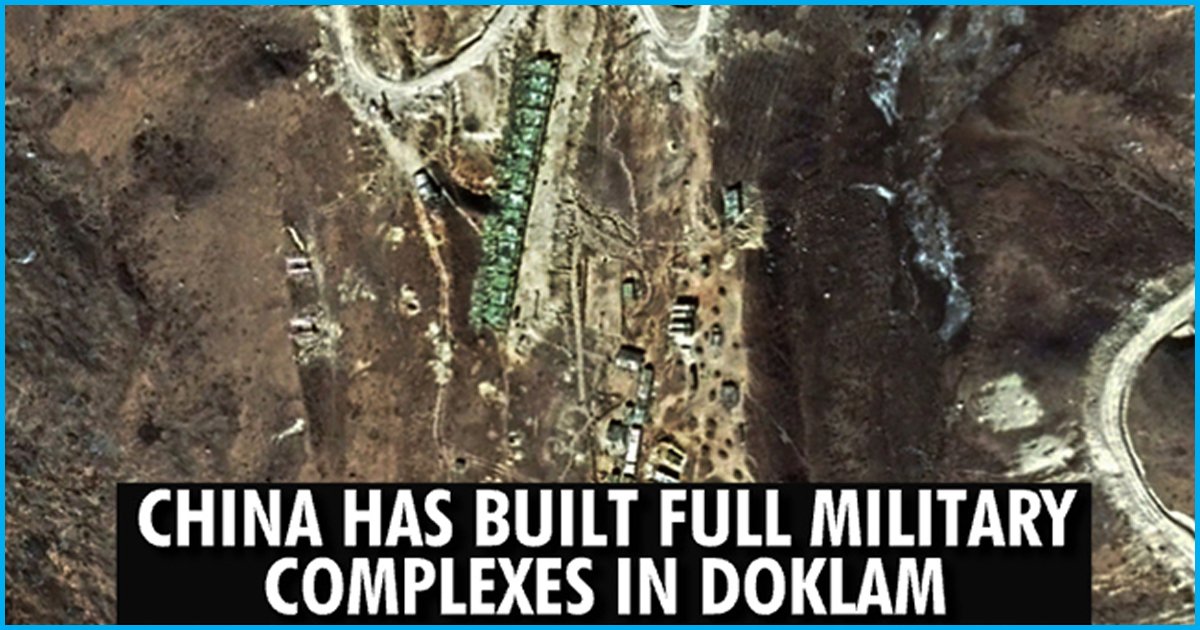Satellite Images Show China Has Built Military Complex In Doklam
18 Jan 2018 12:27 PM GMT
Editor : Pooja Chaudhuri
The only fiction I enjoy is in books and movies.
Satellite images available show a massive, full-fledged Chinese military complex being built within Doklam, five-months after Delhi and Beijing ended a 70-day standoff in the region east of Sikkim.
Last month, the Chinese were building a new road in the 10 km Doklam plateau. This time, satellite images show that they have built several military structures along the East-West road in the disputed region.

NDTV reports that while artillery guns are not visible in these images, there are areas which are dug out and look like gun emplacements. India has always been wary of China moving artillery to this area.
“As far as Doklam is concerned, PLA (People’s Liberation Army) soldiers are there in a part of the area although not in numbers that we saw them in initially. They have carried out some infrastructure development which is mostly temporary in nature,” Army chief General Bipin Rawat said on Wednesday in New Delhi, reported Livemint.

The Chinese are just 81 metres away from the Indian post in Doka la in Sikkim.

Google Earth images from March 2005 and May 2011 clearly show Chinese construction over the years.


Earlier, the External Affairs Ministry had quashed media reports claiming Chinese activity in the region. “We have seen recent reports on Doklam. There are no new developments at the face-off site and its vicinity since the August 28 disengagement. The status quo prevails in this area. Any suggestion to the contrary is incorrect.”
Recent images show that the Chinese never stopped construction in Doklam. “I think the bonhomie (between India and China) has returned to what was prior to Doklam, so I don’t visualize a very serious trouble, but then one has to be prepared for it always,” said the Indian army chief.
China’s stand on the issue was explained by You Dongxiao, an associate professor with the International College of Defense at the National Defense University of the People’s Liberation Army, in a column in Xinhua writing why he thinks the country’s troops are not likely to back down from the stand-off.
First, he believes that Doklam falls under China, citing the 1890 convention between Great Britain and China relating to Sikkim and Tibet to justify that the region has been ‘clearly delineated’ according to the agreement.
Second, that India has not given any ‘legal basis’ for its troops entering the territory and halting Chinese road construction, he argues. Dongxiao questioned when and why Bhutan asked India to step into Doklam to protect its interests.
Third, the writer says it will be ‘ridiculous to conclude’ that China will allow any compromise of its territorial integrity.
Amidst all of this, India has maintained its stand that tranquillity along the India-China border was an important prerequisite for peaceful relations between the two countries.
India and China’s August agreement
The two countries agreed to end the standoff at Doklam after over 2 months of military tension between them.
The Ministry of External Affairs of India released a press statement in this regard:

An official statement had said the step was taken after rounds of bilateral discussions through diplomatic channels, reported The Hindu. The Indian government’s statement hinted that the disengagement understanding was mutually agreed upon by both the nations and China had said that it would continue to patrol the region.
[Read: India & China Agree To End Doklam Standoff: Ex Affairs Ministry]
What is the Doklam border dispute?
Doklam is a narrow plateau lying in the tri-junction region of Bhutan, India and China. It is a disputed territory claimed by both Bhutan and China. The area is roughly situated 15 km southeast of Nathu La pass in Sikkim and on the western edge of the Doklam plateau is Doka La, a pass connecting Sikkim with Tibet.

In June 2017, Doka La became a site of major stand-off between Chnese and Indian troops as the former attempted to extend a road from Yadong further southward on the Doklam plateau. Unlike China and Bhutan, India does not have a territorial claim on Doklam, however, the country supports Bhutan’s claim.
The region is important for India because it provides a tactical edge in Sikkim, Therefore, the construction of roads in Doklam by China will have a direct strategic impact on India, bringing Beijing closer to the Indian mainland in the north-east. New Delhi fears the construction of the road would allow China to cut off India’s access to its northeastern states. Additionally, the country will also be economically impacted because the Chumbi Valley, which is close to the plateau also serves as a trade route from Gangtok through Yadong and Gyantse on to Dalai Lama’s court at Lhasa.
 All section
All section














